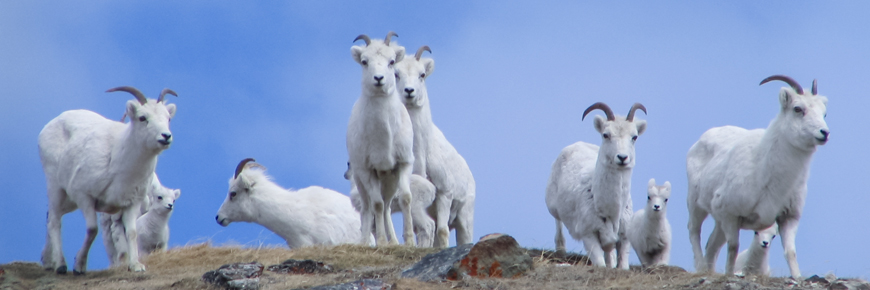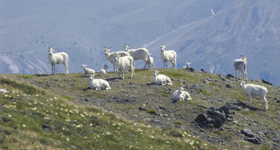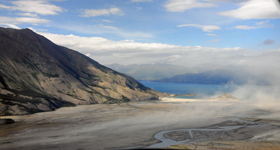
Dall's Sheep of Thechàl Dhâl'
Kluane National Park and Reserve
The big thaw
Every spring, as lengthening days overtake long winter nights, a day comes when the sunlight seems to hold a hint of warmth, and the wind no longer cuts like a knife. Gradually snow becomes rotten and begins to disappear, exposing patches of frozen earth beneath. On the barren, south facing slopes of Thechàl Dhâl', in the north end of the park, the melting and thawing releases a precious bit of moisture into the powdery soil. This is sufficient for sage, adapted to growing on these dry, windswept slopes, to start greening up.
Famine and feast

For the Dall's sheep who have spent long winter months foraging here on dried sage supplemented by the dried leaves and tips of willow twigs exposed by the winter winds, the fresh greenery is badly needed. Their winter diet does not provide them with adequate sustenance. They must also rely on their reserves of body fat to get them through the winter. Spring signals the end of the long winter famine.
Soon after the last of the snow disappears from the lower slopes, the ewes, heavy with lamb, retreat one by one to the solitude of nearby cliffs, to give birth. Within days they return to the open slopes with their newborn lambs, watchful for the ever-present threat of predators, the Golden Eagle and the Grizzly bear, eager to prey on their lambs.

In search of greener pastures
By the time the solstice ushers in the short northern summer, the sheep have followed the retreating snowline and freshly emerging vegetation to summer pastures in the high country. The ewes, with newborn and yearling lambs, migrate in nursery groups, while the mature rams, with their spiralled horns, travel in separate bachelor herds.
Dust of ages
Abandoned, the slopes of Thechàl Dhâl' bask in the gentle sunlight of the long summer days overlooking the valley of the Ä´äy Chù (Slim’s River). Once, the Ä´äy Chù´ was a great river of ice, a glacier, creeping down the valley grinding bedrock into a flour-like powder. And then the glacier melted back, leaving the rock flour thick on the valley floor.

Since that time, summer winds—the restless marriage of warm coastal air and cold glacial breezes—have frolicked down the valley stirring up clouds of this mineral rich dust; draping it across the valley-facing slopes of Thechàl Dhâl'. The accumulation of dust over the ages has formed a layer of wind deposited soil known as loess. The loess supports the sage which grows undisturbed all summer long, awaiting the return of the sheep.
Carousel of time
As summer wears on, the days begin to shorten. And the temperatures drop. Snow begins to accumulate in the high country, pushing the sheep back to the slopes of Thechàl Dhâl' overlooking the Ä´äy Chù´valley. This is the shakat, the First Nations’ traditional autumn harvest season. And the time of the rut. When the rams, in peak condition after their summer feast, joust to determine who gets to mate. As breeding winds down a skiff of snow dusts the lower slopes and valley floor. And the ever-present winds blowing down off of the glaciers, begin to cut like a knife. And the brief northern autumn gives way to the long northern winter. And the cycle of life begins again.
Learn More
Since 1977 Parks Canada has conducted helicopter surveys to determine the health of Kluane's Dall’s sheep populations.
Learn more about ecological monitoring in Kluane National Park and Reserve.
- Date modified :